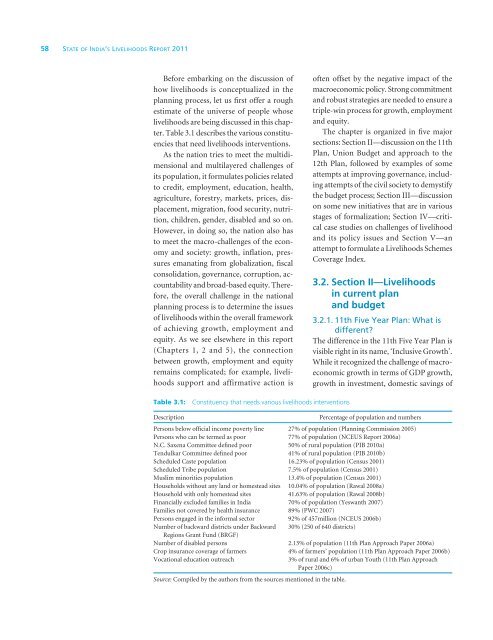SOIL Report 2011 - ACCESS Development Services
SOIL Report 2011 - ACCESS Development Services
SOIL Report 2011 - ACCESS Development Services
- No tags were found...
You also want an ePaper? Increase the reach of your titles
YUMPU automatically turns print PDFs into web optimized ePapers that Google loves.
58 State of India’s Livelihoods <strong>Report</strong> <strong>2011</strong>Before embarking on the discussion ofhow livelihoods is conceptualized in theplanning process, let us first offer a roughestimate of the universe of people whoselivelihoods are being discussed in this chapter.Table 3.1 describes the various constituenciesthat need livelihoods interventions.As the nation tries to meet the multidimensionaland multilayered challenges ofits population, it formulates policies relatedto credit, employment, education, health,agriculture, forestry, markets, prices, displacement,migration, food security, nutrition,children, gender, disabled and so on.However, in doing so, the nation also hasto meet the macro-challenges of the economyand society: growth, inflation, pressuresemanating from globalization, fiscalconsolidation, governance, corruption, accountabilityand broad-based equity. Therefore,the overall challenge in the nationalplanning process is to determine the issuesof livelihoods within the overall frameworkof achieving growth, employment andequity. As we see elsewhere in this report(Chapters 1, 2 and 5), the connectionbetween growth, employment and equityremains complicated; for example, livelihoodssupport and affirmative action isoften offset by the negative impact of themacroeconomic policy. Strong commitmentand robust strategies are needed to ensure atriple-win process for growth, employmentand equity.The chapter is organized in five majorsections: Section II—discussion on the 11thPlan, Union Budget and approach to the12th Plan, followed by examples of someattempts at improving governance, includingattempts of the civil society to demystifythe budget process; Section III—discussionon some new initiatives that are in variousstages of formalization; Section IV—criticalcase studies on challenges of livelihoodand its policy issues and Section V—anattempt to formulate a Livelihoods SchemesCoverage Index.3.2. Section II—Livelihoodsin current planand budget3.2.1. 11th Five Year Plan: What isdifferent?The difference in the 11th Five Year Plan isvisible right in its name, ‘Inclusive Growth’.While it recognized the challenge of macroeconomicgrowth in terms of GDP growth,growth in investment, domestic savings ofTable 3.1: Constituency that needs various livelihoods interventionsDescriptionPercentage of population and numbersPersons below official income poverty line 27% of population (Planning Commission 2005)Persons who can be termed as poor 77% of population (NCEUS <strong>Report</strong> 2006a)N.C. Saxena Committee defined poor 50% of rural population (PIB 2010a)Tendulkar Committee defined poor 41% of rural population (PIB 2010b)Scheduled Caste population 16.23% of population (Census 2001)Scheduled Tribe population 7.5% of population (Census 2001)Muslim minorities population 13.4% of population (Census 2001)Households without any land or homestead sites 10.04% of population (Rawal 2008a)Household with only homestead sites 41.63% of population (Rawal 2008b)Financially excluded families in India 70% of population (Yeswanth 2007)Families not covered by health insurance 89% (PWC 2007)Persons engaged in the informal sector 92% of 457million (NCEUS 2006b)Number of backward districts under Backward 30% (250 of 640 districts)Regions Grant Fund (BRGF)Number of disabled persons 2.13% of population (11th Plan Approach Paper 2006a)Crop insurance coverage of farmers 4% of farmers’ population (11th Plan Approach Paper 2006b)Vocational education outreach3% of rural and 6% of urban Youth (11th Plan ApproachPaper 2006c)Source: Compiled by the authors from the sources mentioned in the table.














